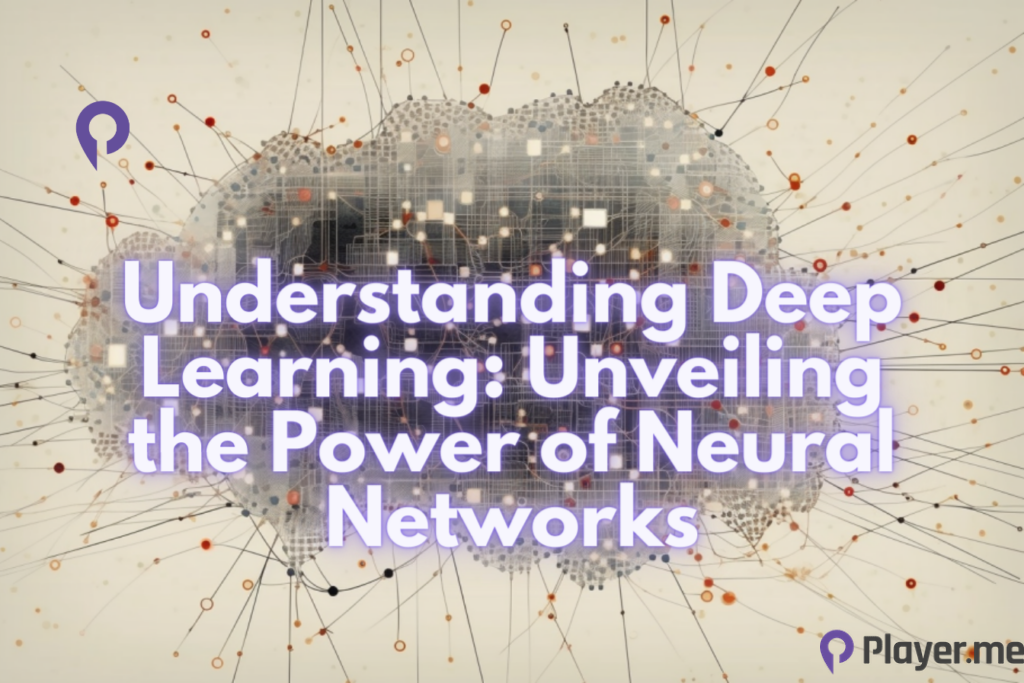Want to explore the fascinating world of deep learning and discover the incredible power of neural networks? Be amazed by how machines learn and adapt, just like the human brain. Neural networks, at the forefront of artificial intelligence, are changing the technology landscape as we speak of it.
With deep learning, machines can analyse large amounts of data, uncover hidden patterns, and gain groundbreaking insights. From self-driving cars to personalised healthcare, the possibilities are endless.
Uncover the secrets of deep learning and witness the extraordinary abilities of tomorrow’s neural networks. Get ready for an awe-inspiring journey into the limitless potential of this field.
Also read: What Are Cloud-Based Solutions?
What Is Deep Learning?
Deep learning, a facet of artificial intelligence, emulates how humans acquire knowledge, making it a crucial component of data science. It aids data scientists in efficiently collecting, analysing, and interpreting large volumes of data. Unlike linear algorithms of traditional machine learning, deep learning employs a stacked structure of increasing complexity and abstraction.
To grasp the concept of deep learning, envision a toddler uttering their first word: “Dog”. Through pointing and verbalising, the toddler learns what defines a dog and distinguishes it from other objects. Guided by parental responses, the toddler progressively discerns the defining features shared by all dogs. Unbeknownst to them, the toddler builds a hierarchical structure, each layer informed by the knowledge acquired from the preceding one, refining the abstraction of the dog concept.
Understanding Deep Learning
Neural Networks: Architecture and Activation Functions
Deep learning operates through the training of deep neural networks composed of multiple layers of artificial neurons. These layers include an input layer, one or more hidden layers, and an output layer. The neurons, nodes, or units receive inputs, perform mathematical transformations, and transmit the results to the subsequent layers.
Activation functions introduce complexity and enable the network to learn intricate relationships. These functions add non-linearities to the network, enhancing its capability to capture and represent complex patterns. Commonly used activation functions include the sigmoid function, hyperbolic tangent (Tanh) function, and rectified linear unit (ReLU).
Leveraging Convolutional and Recurrent Neural Networks
Convolutional Neural Networks (CNNs) for Image Processing
For image-processing tasks, Convolutional Neural Networks (CNNs) are extensively utilised. CNNs employ convolution, where small filters or kernels slide over the input image, extracting local features. CNNs learn hierarchical representations of images through multiple convolutional and pooling layers, facilitating tasks such as object detection, image classification, and image segmentation.
Recurrent Neural Networks (RNNs) for Sequence Data
To handle sequential data like text, speech, and time-series data, Recurrent Neural Networks (RNNs) are specifically designed. RNNs incorporate feedback connections, enabling information to flow from the current input to previous inputs. This recurrent structure empowers RNNs to capture temporal dependencies and efficiently process sequential information.
How Does Deep Learning Work?
Deep Learning is divided into two processes which are defined as:
Autonomous Feature Extraction
In traditional machine learning, programmers face the laborious task of manually defining the features required to identify objects, such as dogs, in images. This process, known as feature extraction, heavily relies on explicit instructions provided by the programmer. However, deep learning breaks free from these constraints, autonomously building its own feature set without human supervision.
The Unsupervised Advantage: Faster and More Accurate
Deep learning programs possess the remarkable ability to create complex statistical models directly from their iterative output. Unlike supervised learning, where explicit labelling is required, deep learning autonomously constructs meaningful patterns and correlations from large quantities of unlabeled and unstructured data. This capability accelerates the learning process and often results in higher accuracy.
Iterative Refinement and Rapid Knowledge Acquisition
Deep learning harnesses the power of multiple processing layers to iteratively refine its predictive models, acquiring knowledge at an extraordinary pace. This hierarchical structure, called “Deep”, enables the program to efficiently analyse and understand complex data patterns, such as identifying dogs in images.
From Basic Assumptions to Advanced Recognition
Initially, deep learning programs start with simple assumptions about the features that define a particular object based solely on pixel patterns in digital data. The program refines its predictive models through iterations, gradually incorporating more nuanced and accurate representations. For example, a basic assumption may be that dogs have four legs and a tail, leading to subsequent iterations refining the model’s understanding of dog-specific features.
Swift Knowledge Acquisition: From Weeks to Minutes
While it takes weeks or even months for a toddler to grasp the concept of a dog, deep-learning algorithms can process vast amounts of data in minutes. By quickly analysing millions of images, the program can accurately identify the presence of dogs, showcasing the unparalleled speed and efficiency of deep learning’s knowledge-acquisition capabilities.
Applications of Deep Learning
Image Recognition
Revolutionising visual data analysis with deep learning’s exceptional performance in image recognition tasks, including object recognition, image classification, and image segmentation. Applications span industries such as self-driving cars, medical imaging, and content-based image retrieval.
Natural Language Processing (NLP)
Pushing the boundaries of language understanding and generation, deep learning revolutionises NLP tasks like translation, sentiment analysis, question answering, and language generation. Key advancements include recurrent neural networks (RNNs) and transformer-based architectures like BERT and GPT.
Healthcare
Deep learning’s significant contributions to healthcare empower medical professionals in critical decision-making processes. From medical diagnosis to disease prediction and personalised treatment plans, deep learning models analyse medical images, predict disease progression, and provide valuable insights, improving patient outcomes.
Customer Experience (CX)
Deep learning revolutionises customer experience by powering chatbots and driving improved CX across various industries. As deep learning matures, it is expected to enhance businesses’ ability to understand and respond to customer needs, ultimately boosting customer satisfaction.
Text Generation
Machines can now generate new texts that match an original text’s grammar, style, and spelling. By teaching deep learning models the intricacies of grammar and style, businesses can automate the process of creating fresh and coherent written content.
Aerospace and Military
Deep learning plays a pivotal role in satellite image analysis, enabling the detection of objects and identifying areas of interest. It also assists in determining safe or unsafe zones for troops, enhancing decision-making capabilities in the aerospace and military sectors.
Industrial Automation
Worker safety in industrial environments like factories and warehouses is being improved through deep learning applications. By automatically detecting when a worker or object approaches dangerous proximity to machinery, deep learning helps prevent accidents and ensures a safer work environment.
Frequently Asked Questions
What’s the Difference Between Deep Learning and Machine Learning?
Deep learning, a subset of machine learning, differs in problem-solving approach. While machine learning relies on domain expertise to identify important features, deep learning progressively understands features, eliminating the need for such expertise.
This makes deep learning algorithms slower, taking hours or longer, while machine learning algorithms train within seconds to hours. However, during testing, deep learning algorithms outperform machine learning algorithms as testing time increases with data size in machine learning.
What Are the Limitations and Challenges of Deep Learning?
Deep learning requires large amounts of data. Furthermore, the more powerful and accurate models will need more parameters, which, in turn, require more data.
Once trained, deep learning models become inflexible and cannot handle multitasking. They can deliver efficient and accurate solutions but only to one specific problem.
Even solving a similar problem would require retraining the system. Any application that requires reasoning — such as programming or applying the scientific method — long-term planning and algorithm-like data manipulation is completely beyond what current deep learning techniques can do, even with large data.
Which Computer Hardware Is Needed for Deep Learning?
Essential Hardware for Deep Learning:
- High-Performance GPUs: Graphics Processing Units with parallel processing capabilities accelerate deep learning computations.
- Sufficient Memory: Ample RAM capacity facilitates efficient handling of large datasets and intermediate computations.
- Fast Storage: Solid-State Drives enable quick access to training data and model checkpoints.
- Cluster or Cloud Computing: Distributed systems or cloud platforms offer scalability and computational power for training large-scale deep learning models.
Author Profile
Latest entries
 GAMING2024.06.12Top 4 Female Tekken 8 Fighters to Obliterate Your Opponents in Style!
GAMING2024.06.12Top 4 Female Tekken 8 Fighters to Obliterate Your Opponents in Style! NEWS2024.03.18Elon Musk’s SpaceX Ventures into National Security to Empower Spy Satellite Network for U.S.
NEWS2024.03.18Elon Musk’s SpaceX Ventures into National Security to Empower Spy Satellite Network for U.S. GAMING2024.03.17PS Plus: 7 New Games for March and Beyond
GAMING2024.03.17PS Plus: 7 New Games for March and Beyond GAMING2024.03.17Last Epoch Necromancer Builds: All You Need To Know About It
GAMING2024.03.17Last Epoch Necromancer Builds: All You Need To Know About It





